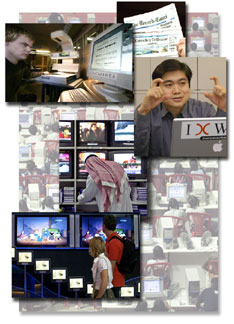|
|
|
 |
|
|
The
Media in the United States > Introduction |
|
The U.S. media today is frequently known as the Fourth Estate, an appellation that suggests the press shares equal stature with the other branches of government created by the Constitution. The press, or "Fourth Estate" plays a vital role as a guardian of U.S. democracy. That role is guaranteed by the First Amendment to the U.S. Constitution, adopted in 1789, stipulating that Congress not enact any laws abridging freedom of the press. U.S. media have traveled a long road since the first newspaper was published in Boston, Massachusetts in 1690. Within 50 years, magazines also began appearing in several major American cities. The advent of commercial radio at the beginning of the 20th century ended print's monopoly of the media in America, giving nationwide and, later, global audiences unprecedented access to live audio programs. Television, an even more powerful medium, entered the scene shortly after World War II. Defying predictions of their decline, the other media have diversified to confront television's dominant appeal. Satellite technology has allowed U.S. TV networks, especially cable networks, to reach overseas audiences anywhere on the globe. Interactive media, fueled by the advance of digital technology and the growing convergence of the computer, telephone and cable television, represent the principal trend of the end of the 20th and the beginning of the 21st centuries. The print and electronic media in the United States, offering wide news and entertainment options, are a pervasive element in American society. According to a recent survey by Mediamark Research, 98% of Americans have a television; 82% of those watch "prime time" and 71% cable programming in an average week. 84% percent of Americans listen to radio regularly. 79% percent are newspaper readers. 45% percent of the whole American population has access to the Internet, while for certain demographic groups that percentage reaches a high of close to 70%. Economics plays a major role in shaping the information served up to the U.S. public in newspapers, on radio and television, and now on the Internet. While nonprofit and advocacy organizations have significant voices, most of the public's primary sources of information -- major urban newspapers, the weekly news magazines, and the broadcast and cable networks -- are in business to make money. Media and communications, with revenues of over $242 billion, are one of America's largest business groups. In 2000, adult consumers of media information and amusement products spent over $675 a person. Advertisers spent an additional $215 billion to bring their products to the attention of the American public. The media are a great engine in American society, providing jobs for hundreds of thousands of technicians, writers, artists, performers and intellectuals and shaping attitudes and beliefs. |
|||
|
|||
| Texts
are abridged from U.S. State Department IIP
publications and other U.S. government materials. |
|||
| What
kind of information materials are available?
CD: These documents are available in fulltext format on the About the USA CD-ROM. Teachers: Request a copy for classroom use. L: Selected documents are available in German as well as other languages, including Arabic, Chinese, French, Spanish, Persian and Turkish. |
DISCLAIMER
Any reference obtained from this server to a specific commercial product, process, or service does not constitute or imply an endorsement by the United States Government of the product, process, or service, or its producer or provider. The views and opinions expressed in any referenced document do not necessarily state or reflect those of the United States Government. |
 U.S. Diplomatic Mission to Germany /Public Affairs/ Information Resource Centers Updated: March 2010 |
